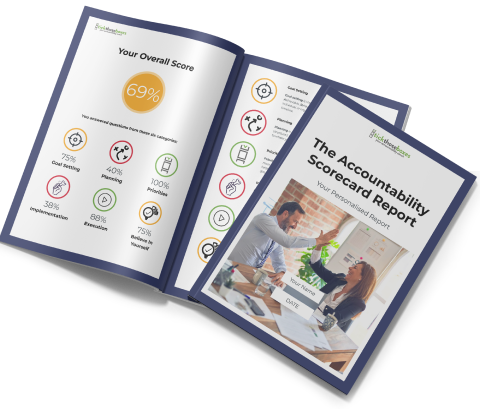
Accountability for Business Owners
Learn how accountability can help business owners build more sustainable
The Accountability Guy®

In our previous blogs, we discussed tips to improve employee accountability and build an accountable workplace culture. But what about the critical question that helps us lead to better employee accountability? So, now let us understand and look at the possible questions. For example, when we talk about employee accountability, we are talking about better employee engagement and commitment towards his job roles, performance, and results, developing proactive nature to provide problem-solving skills and solutions, and accepting feedback and change for betterment. But what if the employee we work with needs to be improved or adaptive enough to our goals and are not ready to change? Or let’s say the employees are struggling to change towards accountability.
Of course, every employee wants to change and develop in their roles, but if they are stuck and unable to achieve the goals that we might have planned for them? How can we help them? What can we provide as an organization for them to improve? How can we make sure that they do not get stuck and struggle? Before we answer this question, let us look at the various reasons why any employee would get stuck.

Discover your Accountability Score and increase the probability of smashing your GOALS and Getting Sh!t Done!
When an employee targets an expectation of a new goal or improvement change, he might start avoiding or completing that job in the most unproductive way—leading the organization with more damage than being fruitful because the employee is in haste to complete that task but might not understand the importance or understand it completely how it can achieve it productively. Once this situation occurs, the employee’s thinking capability goes reactive toward a fight-flight response. These fight-flight responses are nothing but the fear of change in their minds, where he loses any rational way of achieving the goal but begins to avoid or ignore or even fight out of it.
The first fight- Flight response is where the employee understands the importance of the goal provided, but then he starts to perform other tasks that can provide assured success. He will try to delay it as much as possible. For example, if an organization gives time to an employee to improve one aspect of his performance, he is neglecting it.
The second fight- flight response is where the employee learns to reject the change. He is well aware that there is an expectation for him to change certain aspects of his performance, but he fights not to change. That way, it becomes difficult for the managers to understand how they can improve if they don’t accept the change.
The third fight- flight response is ignorance or de-prioritizing when the employee doesn’t understand the importance of the change. He then tends to ignore or forget about the change. He will then de-prioritize the tasks with other tasks to ensure he can avoid them for as long as possible.
So, how do we change this fear of change into acceptance to change? So, let us discuss the question now!
So, one powerful question to improve employee accountability for us is how to change the fear of change into confidence and acceptance. And the answer is a simple focus on smaller targets, and if the difference is too big, then break it into smaller parts and focus on them one by one. Finally, keep the employees from feeling overwhelmed about any target. Sit and understand their fears and concerns, and help them tackle them positively. Finally, refrain from letting them begin to think negatively, and preach to them the positive aspects of achieving the goals one after another. This way, they will learn to be more engaged in their job roles and targets, develop proactive thinking, and be receptive to feedback and change. Finally, they will not feel stuck in any situation and will be confident to handle it and have an open conversation with the manager.

Darren Finkelstein, The Accountability Guy®, is the founder of TICK THOSE BOXES, a specialised accountability coaching practice. Darren is a formidable international accountability coach, business advisor, mentor, and author/speaker, fostering development and measurable results in entrepreneurship, leadership, and accountability. Darren’s tale is one of perseverance, self-reinvention, and resilience.
With compelling execution, Darren has empowered high-achieving individuals and teams from Australia and New Zealand to Latin America, Europe, Asia, the UK, and the US to embrace accountability; after all, it is your superpower.
Darren’s one-on-one and group coaching programs are based on his bestselling business book, “The Accountability Advantage – Play your best game” and the latest, release “NO’ – Building a life of choice without obligation”.
Darren has an impressive background in business, having held the role of “Manager of Commercial Markets” at Apple Australia during the Steve Jobs revolution.
He enthusiastically “walks the talk,” having also successfully sold and exited his lifestyle businesses, which served as the impetus for establishing his coaching and mentoring business.
Join Darren on this transformative quest to accomplish the remarkable.
Read Darren’s full bio here:
https://tickthoseboxes.com.au/about/

Know what to do first

know what to do next

know what to do more of

Learn how accountability can help business owners build more sustainable

Boost productivity and trust within your team. Unveil the power

Learn about Positive Accountability, see what it is, why you

Accountability drives success in so many ways. Whenever I coach

Are You Responsible or Accountable? The underlying principles undoubtedly apply

Discover why accountability is crucial for effective leadership. Learn how
Navigation
Learn More
Contact
Social Media
Copyright Darren Finkelstein 2022 | Privacy Policy | Terms and Conditions